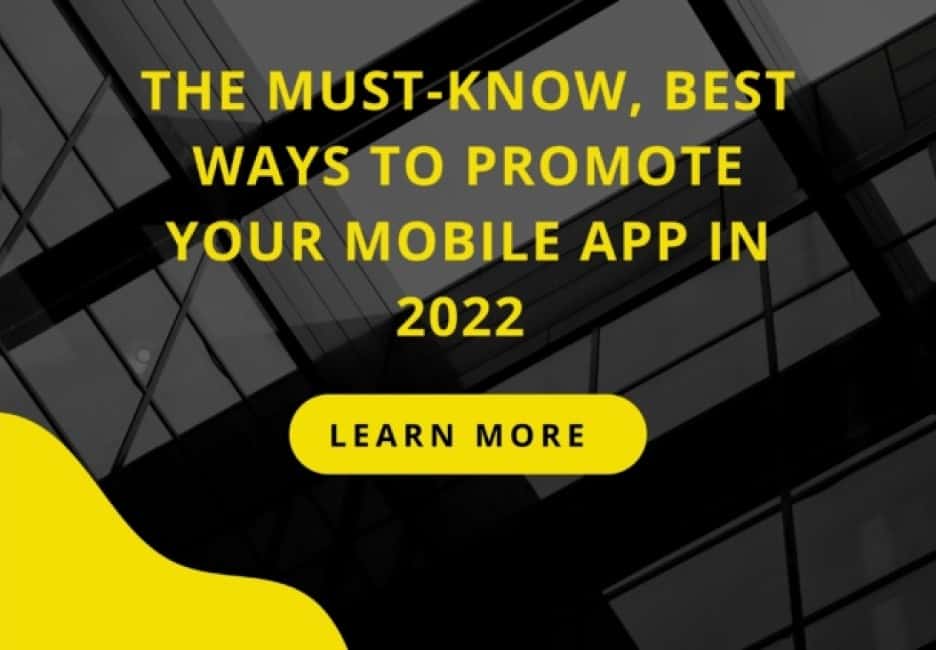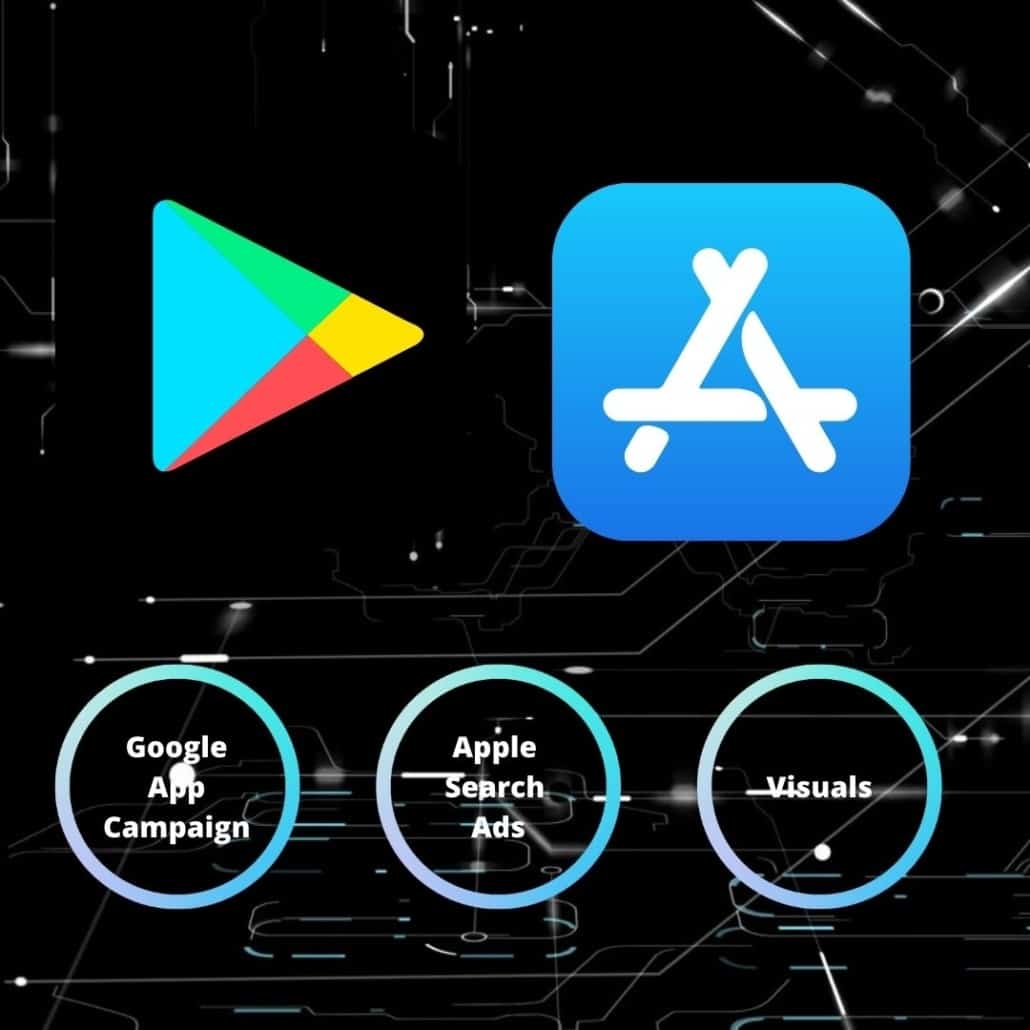
The Must-know, Best Ways to Promote Your Mobile App in 2022
Introduction
Developing a groundbreaking mobile app requires passionate belief in your concept, not to mention extraordinary skill and team talent. Finally, the day arrives to launch, and you can’t wait for customers to appreciate your meaningful differences. You expect them to stream in confirming acknowledgment with their downloads. Unfortunately, it doesn’t work out like that. You quickly learn that innovating a new technology (or one that’s significantly improved) is one thing. Effectively communicating that you’ve arrived with something that will make life easier is another.
Every app developer should know what they’re up against when it’s time to hit the marketplace. In a recent overview (March 2021), Android users had access to 3.48 million apps through Google Play and 2.2 million IOS users through the Apple Store. The numbers are probably higher going into 2022. Even with categorization, getting your nose in front of the pack requires patience, resilience, and the marketing know-how to promote for the best results.
Developers everywhere in the US want to know how to promote an app coming on to The Apple Store or Google Play for the first time. This article aims at paving the way for you to get traction quickly, generating revenue beyond expectations, and making every dollar in your budget count. Another big query revolves around how to promote your app for free. We believe the content below will provide helpful insight.
In summary: We intend to provide the seven best answers to the three most perplexing challenges most developers face when trying to commercialize their app:
- How to promote an app.
- How to advertise your app
- How to promote your app for free.
1. The first line of attack – Friends and Family
Undoubtedly, it’s the smoothest route to seeing downloads fast. Get your team together and draw up a list of people you interact with frequently, likely to support your initiative and root for you to succeed. As part of your inner circle, they’re the ideal starting point to get the traction you desire.
Here’s the thing: The friends and family suggestion frequently receives a lukewarm reaction because entrepreneurs see it as:
- Taking advantage of a relationship.
- Limited in scope based on there only being so many people in this category.
If these thoughts are going through your mind, you’re wrong. Firstly, true friendship thrives on being there for each other, basking in the success of people you know well. Secondly, the domino effect of first-time users telling others in their community about your app is massively compelling. Indeed, Early Adopters (EAs) have the power to kickstart your business – indicating there’s something real behind it.
Spreading usage isn’t the only benefit in the equation. Here are some suggestions that’ll get maximum mileage from going the EA route
- Offer download and usage incentives.
- Go further by incentivizing referrals to your friends’ friends (not necessarily yours).
- Encourage them to submit glowing reviews.
- Notwithstanding the reviews, seek constructive suggestions for improvement.
2. Organic installs via App Store Optimization strategies.
App store optimization (ASO) is vital for breaking through the masses and becoming a user consideration. Did you know that 65% of all app downloads credit their success to ASO? It indicates that most mobile app users don’t have a particular brand in mind when they enter the search process to ignite their customer journey (CJ). Instead, they rely on keywords to throw up engaging solutions.
A. What does ASO cost?
When developers look into the challenge of how to promote your app for free, the first thing that seems to pop up is ASO. The objective in ASO strategies is to emerge in searches in the top three on the App Store page – certainly not lower than #5. Searchers assume the highest-ranked represent the best options. Articles and digital agencies tell you that “organic” implies no advertising cost.
So, yes, organic searches on the surface are free. However, it takes digital marketing resources and expertise to carve out an effective ASO plan that puts you at the front of the search results. Unless someone in your team has those capabilities, your budget must account for hiring them. A carefully structured ASO program should work out on a relatively thinner budget. Still, deflecting frustration as you go through a trial-and-error process to maximize app visibility and conversions requires a dollar investment.
B. Why are keywords a crucial driver to ASO success?
The straightforward answer is that they determine how easily searchers discover your app and, once they do, how attractively your proposition resonates with the audience. Keywords provide the glue that connects the critical determinants simultaneously, namely:
- Getting you a high App Store ranking.
- Then, once the searcher clicks on your entry, showing:
- An eye-catching presentation
- High ratings
- Impressive reviews
Deriving the keywords that work best for your app is a science. The first inclination is to go for the one attracting the most searches in your industry.
Example: Let’s say you have a gaming app. You noticed that people searching for games use the term “internet games” over 40,000 times monthly. However, the chances of coming up prominently on that search term are minimal. Why? Because the competition is intense. Millions are applying the best ASO practices ahead of you. Face the facts, as a latecomer in an overcrowded market, blasting ahead of the herd is virtually a pipedream.
So, is there a solution to the challenge of jumping to the top of a search list? Of course – the answers lie in market segmentation principles. Instead of going for a minuscule percentage of a massive market, aim for a significant share of a small niche market. In other words: Look for search terms that have the following three characteristics working in unison, They represent:
- Enough volume to keep you busy if only 5% of the searchers respond.
- A low competition factor (versus medium or high).
- As close a description of your primary app features/benefits as possible.
Your gaming game, for instance, may involve no violent interactivity for enjoyment (something unique these days). It may also:
- Be progressive in difficulty, providing an almost endless challenge.
- Meet the needs of kids from ten years old and up.
Therefore, we advise you to look for:
- Longer search terms (probably with significantly less volume than “internet games”) but far fewer competitors using them.
- Keywords that reflect:
- Non-violence
- Enjoyment for the family, even juveniles.
- Suitability for, but also great for improving skill levels.
- Additionally, “internet” games” as a bonus but not a must.
Tip to round off: Focus on small market segments, but aim big within each one. Avoid overcrowded spaces by looking for the low competition gaps.
3. How to advertise your app with Apple and Google.
You may be a mobile app developer, but, more crucially, you’re in business. Your proprietary technology (or one with new dimensions) is genuinely your product. You may not have to deliver it to a warehouse, store it, and merchandise it, but the digital world has unique characteristics and challenges. Once the app is up and running, it still depends on success-actions that embrace:
- Regular updates.
- Seamless downloads.
- Professional marketing that centers on:
- ASO
- Google Campaigns
- Social Media Promotions (which we deal with in another section)
When people search, they don’t only go to the top-rated ASO occurrences. They inevitably click on paid ads that catch their eye. In short, ASO and the latter represent a collaborative promotional effort to get the audience to engage and download your app. Indeed, the two leading platforms are Apple Search Ads and Google App Campaign. Here’s how they work:
A. Apple Search Ads
Keywords come into this, with one big exception. If you succeed in bidding for keywords in the Search Ad format, the audience will see your ad before the # 1 organic search result. That’s great, you say! Not exactly. Two considerations impact paid ad decisions:
- The cost to your company of winning the bid.
- How relevant the keywords are to your product.
If you end up paying for too many clicks at an exorbitant price, conversion rates suffer, and it’s cash down the drain. So, again, you have to pick your keywords with much forethought and weigh the costs against the expected conversions.
As a rule, Apple ads are effective, with a 50% conversion rate and a 65% download rate. Indications are that developers understand the protocols and parameters involved in this side of promoting.
B. Google App Campaign
The system rides on carving out a segmentation definition that fits the app’s benefits and goals best. The logic behind it is that Google wants your ads to align closely with the target audience’s needs and result in a high download probability. Therefore, include your campaign goals as part of the app installs and then leave it to Google to structure the campaign to achieve them.
C. Visuals
Screenshots and your app icon speak louder than a thousand words. Prospects rely on them to make up their minds. So, even if your app makes an appearance with the right message and initiates a click-through by coming up top of the page:
- Poor visuals can lose the sale by disintegrating interest like ice under the Arizona sun.
- The potential behind Google Campaign and Apple Search Ads can’t work in your favor if your visuals are drab or second rate.
4. How to promote new app benefits with social media power
Don’t ignore social media promotions if you want to get your app firing on all cylinders. There are some exceptions because it doesn’t work well for certain apps, but most should include it in their promotional program:
- Theoretically, you can go a paid or organic route on these platforms.
- Organic, practically speaking, has severe limitations in a massively saturated space.
- Therefore, we’ll stay with the paid format only, where Facebook, Instagram, Snapchat, and TikTok offer robust app install campaigns.
You can be sure that browsers searching for apps in social media go directly to your app store listing when clicking on a CTA. So, if you want them to download, it’s vital that you construct an excellent one through App Store Optimization. Social media relies on precise demographics and target segment carve-outs, similar to the Google Campaign methodology, to get optimal click-through results. In this alternative promotional arena, the “buzzword” is Return-On-Ad-Sales (ROAS) as a measure of success.
However, remember that the primary social media platforms vary considerably, particularly in audience appeal. It means you should research the landscape carefully, learning about the relative limitations and advantages.
5. Expand your Audience with Influencer Marketing
A crucial energizer of human behavior is powerful word of mouth, and there’s none better in this category than the recommendations of aspiration groups. Human beings worldwide conduct their lives by behaving in the same ways they expect people they admire to behave. We refer to those who inspire others as influencers and the idea of connecting your app to the latter as influencer marketing. If influencers adopt your brand as their go-to solution for particular needs, their followers are likely to almost without thinking.
For example, Roger Federer undoubtedly influences thousands, if not millions, of young up-and-comers in the sport of tennis. It’s also no secret that his favorite timepiece is a Rolex. Of course, not everyone can or will ever afford to buy the luxury Swiss brand, but it’s likely their automatic choice if only a tiny percentage of his followers can.
So, influential marketing aims to spread brand awareness with targeted audiences, the members of which look up to a personality as a behavioral model. Another way of appreciating influencers is that they function as brand ambassadors by their actions (e.g., Federer wearing a Rolex on and off the court) or promoting it directly as a spokesman. Successful ambassador recruitment depends on accuracy in:
- Matching audiences to influencers.
- Selecting the media that communicates brand/influencer connection.
- Analyzing that your app credibly aligns with the influencer’s lifestyle and behavior.
- Assessing the rewards versus the cost of influential marketing.
- Having a budget that can afford to buy the ambassador’s endorsement.
We recommend that you try contacting influencers directly or through agents representing personalities in this arena.
6. Leverage existing app users to spread the word.
As intimated in our first recommendation – friends and family – and influencer marketing above, word-of-mouth marketing is indispensable. People trust their aspiration groups, friends, and family the most. After that, they look to peers in their community as a reference. Therefore, as users from all walks of life download your app and become brand loyal, it’s vital to leverage their customer experience. There are two ways to do this:
- Develop a referral program that offers rewards (e.g., free coins) to committed users if they can convince their inner circle to try the app out.
- By soliciting five-star user reviews at every opportunity to publicize through social media and your app store listing pages.
The primary driver in both of the above is trust. The more there is of it and the more emphatically you can spread it, the faster your market traction will emerge.
7. Create a compelling website
Customers expect their brands to have an official online representation. Almost everyone considering an app download wants confirmation that they’re making the right decision. Websites provide just that and have universal recognition as the least a company must do to establish professionalism.
- It’s a fair bet that anyone connecting to your brand through ASO, influence marketing, referrals, or paid advertising will double-check by looking for website information.
- It serves as another motivating touchpoint in the customer journey (CJ). Omit it and the chances the entire CJ will tank.
Aside from the above, a search engine optimized (SEO) website can generate traffic outside of all other avenues cited in this article. New visitors discovering your app via Google navigation likely adds more downloads.
Conclusion
Promoting your app in 2022 has its challenges, but nothing succeeds like a committed, strategic approach; one that relies on multiple options, paid and organic. Of course, costs must weigh into the considerations, but a balanced approach as described above makes the most sense. You can rely on ShyftUp – a leading global User Acquisition Agency – to help you decide.
ShyftUp focuses on two primary services App Store Optimization (ASO) and Paid User Acquisition, helping clients nationwide to get more downloads and solidify user loyalty. Moreover, Shyfttup specializes in Apple Search Ads and Google UAC.
1. The first line of attack – Friends and Family
2. Organic installs via App Store Optimization strategies.
B. Why are keywords a crucial driver to ASO success?
3. How to advertise your app with Apple and Google.
4. How to promote new app benefits with social media power
5. Expand your Audience with Influencer Marketing
6. Leverage existing app users to spread the word.

